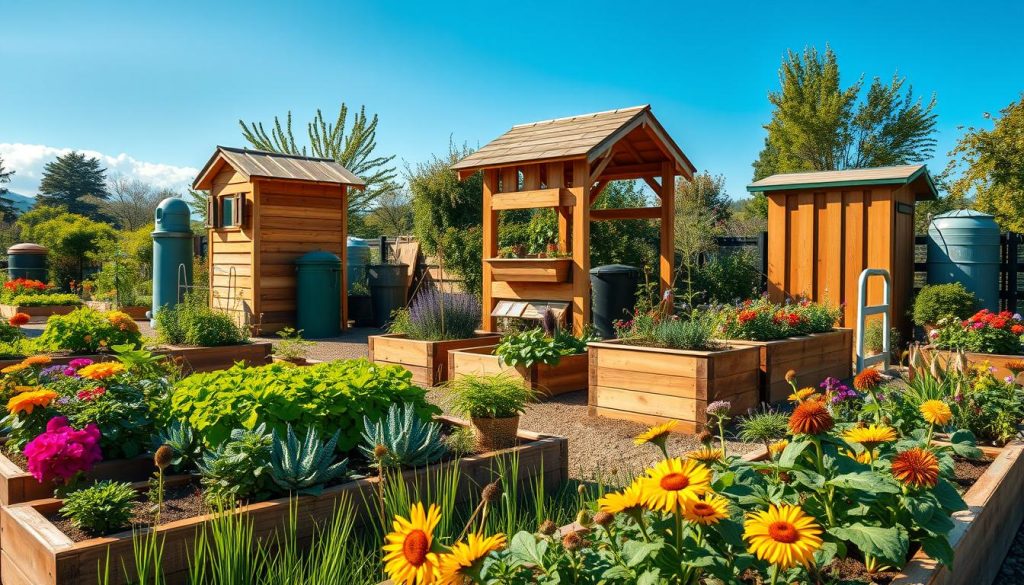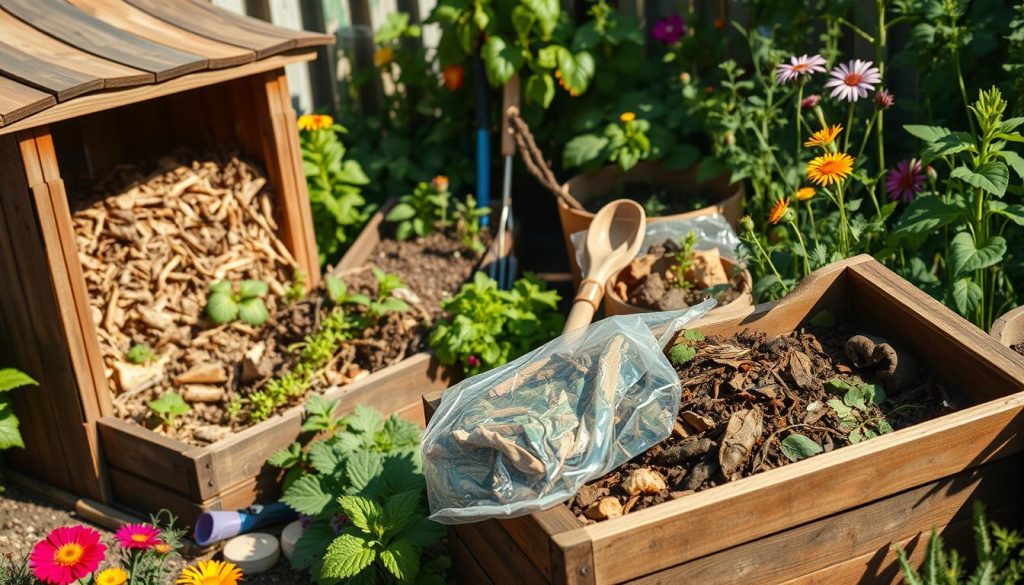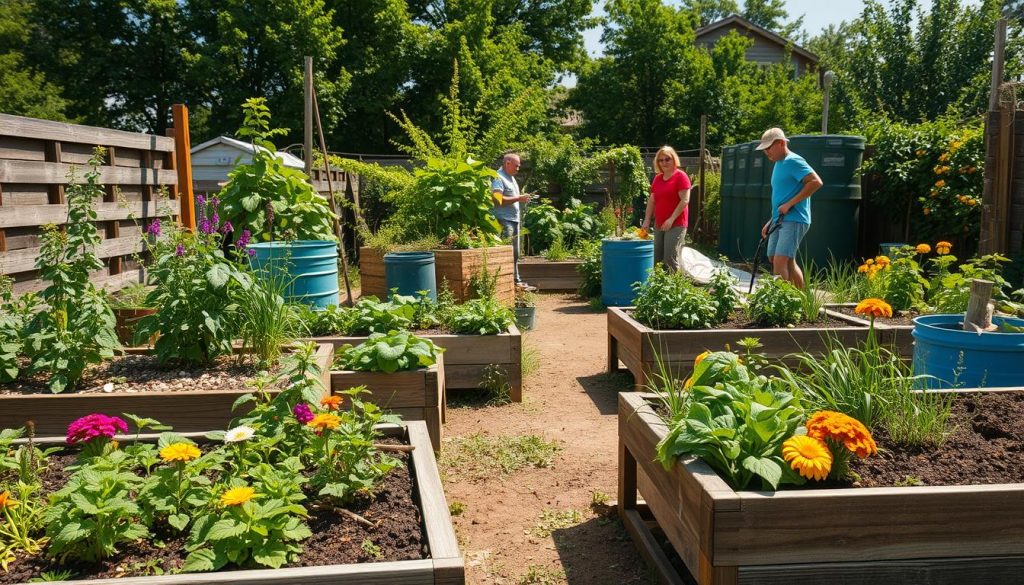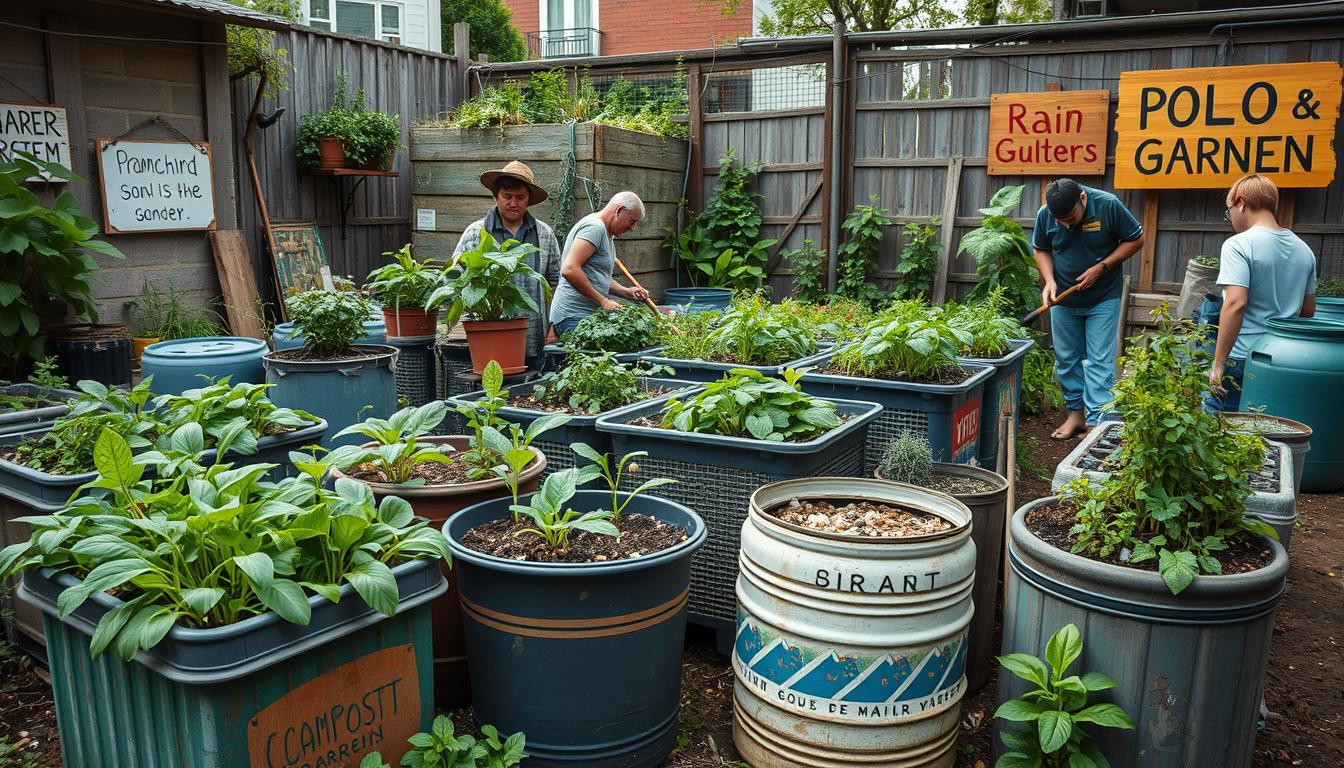I’m excited to share my zero-waste community garden tips. These tips will help you create an eco-friendly oasis. By following these tips, you can make a beautiful and sustainable garden that’s good for you and the environment.
Using eco-friendly gardening tips can greatly reduce waste and help the environment. In this article, we’ll look at the benefits of zero-waste gardening. We’ll also give you practical tips on starting sustainable gardening practices and eco-friendly gardening tips.
We’ll cover everything from preparing your garden space to picking the right plants. Our focus will be on zero-waste community garden tips and sustainable gardening practices. These will help you create a thriving eco-friendly garden.
Introduction to Zero-Waste Gardening
Exploring gardening, I’ve learned the value of waste-free gardening. It’s good for the planet and makes our gardens healthier. By using zero-waste gardening, we cut down on harmful chemicals and promote green gardening.
So, what’s a zero-waste garden? It’s simple: it grows plants naturally. We use compost, rainwater, and natural pest control. This reduces our carbon footprint and saves water.
What is a Zero-Waste Garden?
A zero-waste garden is perfect for plants to grow without harming the environment. It’s a place where we use resources wisely. Features include recycled materials, composting, and efficient water use.
Benefits of Going Zero Waste
Going zero-waste has many benefits. Some are:
- Reduced carbon footprint
- Conserved water
- Healthier and more sustainable garden ecosystem
- Reduced waste and pollution
Adopting waste-free gardening helps our planet. It’s good for the environment, no matter your gardening level. Adding zero-waste gardening to your routine makes a big difference.
Preparing Your Community Garden Space
Starting my community garden, I focus on green tips for a sustainable space. I check the sunlight, soil, and water to find the perfect spot. This helps me design a garden that’s good for the planet, using less waste and harming the environment less.
To make my garden eco-friendly, I’ll use natural and recycled stuff. Old pallets or containers will be turned into planters. This not only cuts down on waste but also makes my garden special. I’ll also follow these green tips:
- Using compost to enrich the soil
- Installing a rainwater harvesting system
- Implementing a drip irrigation system to conserve water
These steps will help me create a vibrant community garden. It will show the good of eco-friendly gardening. I’ll keep sustainability in mind, knowing it’s good for the environment.

Assessing Local Resources
Checking local resources is key for my garden. Knowing about sunlight, soil, and water helps me plan. This also lets me find spots for green tips, like using plants that don’t need much sun or a system to catch rainwater.
Designing for Sustainability
Designing my garden with sustainability in mind is crucial. Using compost and recycled stuff helps reduce waste and environmental harm. As I design, I think about the long-term benefits of green gardening. It’s good for a healthier, more sustainable community.
Choosing the Right Plants
When setting up a zero-waste community garden, picking the right plants is key. I look into zero-waste garden tips to guide my choices. I’ve learned that waste-free gardening saves resources and cuts down on upkeep. Using native plants, for example, helps create a low-maintenance ecosystem.
To start, I consider a few things when picking plants:
- Native plants: These fit the local climate well and need less care, perfect for a zero-waste garden.
- Diversity: A mix of flowers, veggies, and herbs makes the garden strong and attracts helpful insects.
- Low-maintenance: I choose plants that are simple to care for and use fewer resources like water and fertilizers.
By picking the right plants, I aim to build a stunning, eco-friendly garden. This garden will not only help the environment but also offer a peaceful spot for my community.
Native Plants vs. Exotic Plants
Native plants are great for a zero-waste garden because they fit the local climate and need less care. Exotic plants, however, might need more attention and resources, making them less green. Choosing native plants means I use fewer fertilizers and pesticides, making my garden more sustainable.
The Importance of Diversity in Plants
Diversity is crucial for a strong, balanced garden ecosystem. By growing different plants, I attract pollinators and beneficial insects. This keeps my garden healthy and diverse. It also lets me use various green gardening methods, like companion planting and crop rotation, to make my garden thrive.
Composting Techniques for Gardeners
Exploring zero-waste gardening, I learned composting is key. It cuts down waste and makes a natural fertilizer for plants. Using eco-friendly tips like composting, I lessen my environmental impact. I started with a compost bin from reclaimed wood, showing sustainable gardening.
Composting kitchen scraps, like food waste and coffee grounds, works well. These scraps enrich the soil, helping plants grow. Here are composting’s benefits:
- Reduces waste sent to landfills
- Conserves water by helping the soil retain moisture
- Supports the growth of beneficial microorganisms in the soil
Composting in my garden cuts waste and boosts sustainability. It makes my garden ecosystem thrive. This method works for any garden, big or small.

I’m eager to share more eco-friendly tips for gardening. These can help you grow a green and healthy garden.
Water Conservation Strategies
Exploring zero-waste gardening ideas, I see how crucial water conservation is. It helps reduce waste and protects our environment. Using rainwater harvesting is a key green technique. It cuts down on the need for city water.
Collecting rainwater lets me water my plants, clean tools, and fill ponds or fountains. This method is a big step towards a greener garden.
Drip irrigation systems are another smart way to save water. They send water straight to the roots, cutting down on evaporation and runoff. This method ensures my plants get the right amount of water, without wasting any.
By adding these strategies to my gardening, I help my community and the planet. My garden becomes a thriving, sustainable space.
- Reduced water bills
- Increased crop yields
- Improved soil health
- Conservation of this precious resource for future generations
Adopting these green techniques, I positively impact the environment. My garden becomes a beautiful, sustainable haven for years.
Pest Management in a Zero-Waste Garden
Exploring zero-waste gardening shows me how key pest management is. It’s about using sustainable methods to avoid harmful chemicals. Eco-friendly tips help me grow plants healthily and naturally.
Using natural pest control is a smart move. Neem oil and diatomaceous earth are great for this. They keep pests away without harming the environment. This also helps keep the soil healthy with beneficial insects and microorganisms.
Natural Pest Control Methods
- Using neem oil to control insects and fungal diseases
- Applying diatomaceous earth to dehydrate and kill pests
- Encouraging beneficial insects, such as ladybugs and lacewings, to prey on pests
Attracting good insects is key in a zero-waste garden. It helps plants grow well and cuts down on the need for chemicals. This supports a healthy garden and a better environment.

Attracting Beneficial Insects
Planting a variety of flowers and herbs attracts good insects. This makes my garden beautiful and healthy. It’s a win-win for my garden and the environment.
Community Involvement and Education
As I grow my zero-waste community garden, I see how key community involvement and education are. By sharing tips and promoting waste-free gardening, I aim to get more people involved. Green gardening not only helps the planet but also unites us.
Organizing Gardening Workshops
I plan to host gardening workshops to teach about zero-waste gardening. These will cover topics like composting and natural pest control. My goal is to inspire others to garden waste-free and help our planet.
Encouraging Local Participation
To get more people involved, I’ll reach out to schools and community centers. I’ll also start a social media group for updates and tips. Together, we can make a sustainable community garden that benefits all.
Conclusion: Sustaining Your Zero-Waste Garden
Keeping a zero-waste garden alive is a journey that never ends. But the rewards for our community are huge. By using eco-friendly gardening tips, we make our world greener and healthier. This encourages others to join us in caring for our planet.
Long-Term Benefits for the Community
Our zero-waste garden does more than just help us. It benefits everyone around us too. By cutting down on waste and saving water, we make our neighborhood a better place. We learn to love and respect the nature that surrounds us.
Sharing Your Zero-Waste Journey
When we share our zero-waste journey, we inspire others to do the same. We can teach through workshops, community events, and social media. Together, we can make a big change, one garden at a time.

